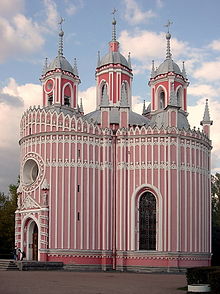Chesme Church
| Chesme Church Church of St John the Baptist Chesme | |
|---|---|
| Church of Saint John the Baptist at Chesme Palace | |
Gothic Revival | |
| Demolished | not demolished |
| Specifications | |
| Materials | Brick with white stone |
The Chesme Church (
The church and Chesme Palace were the earliest Neo-Gothic constructions in the St Petersburg area.
Etymology
The church was named "The Church of the Birth of St. John the Baptist" as it was consecrated on the birthday of
Geography
The church is located in Red Village, which was a country estate of the Sergey Poltoratski family, friends of
History
In 1777, King
The knights of the Order of St. George were also in possession of the church at some point when it was given the third name, "St. George’s Church".[11]

The church and the Chesme Palace became a labour camp when the Soviet government occupied it.
Architecture

The church, built in
The inspiration for adopting the pseudo-Gothic style of architecture was a symbol of "the exoticism of the Turkish architecture but also reflected the
The church was built with brick and white stone.
The exterior views of the church are impressive. The lanterns on the roof are stated to be similar to those seen on the Gothic temple at Stowe House.[14]
Grounds


The church precincts have been used as a resting place for war heroes since the time of its consecration and during the Siege of Leningrad. The cemetery is known as the "Chesmenskoe War Veterans' Cemetery",[7][10] and contains unnamed graves dated 1812–1944 of those who died in Russian wars.[2]
Notable people
The coffin of Rasputin rested in Chesme Church before his burial at Tsarskoye Selo in 1916.[9]
References
- ^ a b "Chesme Church". St Petersburg Encyclopedia. Retrieved 5 February 2011.
- ^ ISBN 978-1-4262-0050-2.
- ^ a b c "The later history of the Green Frog Service". State Hermitage Museum. 2006. Archived from the original on 5 October 2013. Retrieved 9 February 2011.
- ISBN 978-1-74059-827-9.
- ^ a b c "Village of Red. Transfiguration Church". narod.ru. Retrieved 5 February 2011.
- ^ a b c d e f g h i "Church of the Birth of St. John the Baptist (Chesme Church)". Saint-petersburg.com. Retrieved 5 February 2011.
- ^ ISBN 978-1-74104-169-9.
- ^ ISBN 9785730000940. Retrieved 6 February 2011.)
The Chesme Church, built in 1777— 80 by Yury Felten, is one of the few pseudo-Gothic structures in Leningrad architecture. Its name comes from the great naval victory of 1770 over the Turks in the Aegean at Chesme.
{{cite book}}:|work=ignored (help - ^ ISBN 978-1-900639-40-8.
- ^ a b c d e "Chekushi". Chesme Church. St Petersburg Encyclopedia. Retrieved 5 February 2011.
- ^ a b "La chiesa: Chesmenskaja". Intours.com. Retrieved 7 February 2011.
- ^ "Church of the Birth of St. John the Baptist (Chesme Church), St. Petersburg, Russia".
- ^ ISBN 978-90-5699-536-2.
- ^ ]
- ^ Contemporary review. 1990. Retrieved 7 February 2011.
External links
 Media related to Chesme Church at Wikimedia Commons
Media related to Chesme Church at Wikimedia Commons
